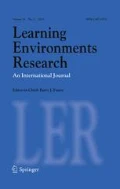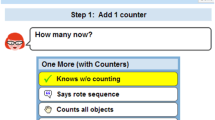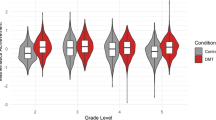Abstract
This study examined the quality of teacher–child interactions and exposure to mathematics instruction as predictors of 5th grade student’s mathematics achievement. The sample was a subset of the children involved in the NICHD–SECC longitudinal study (N = 657). Results indicate that, even after controlling for student demographic characteristics, more exposure to mathematics instruction was related to increased fifth grade mathematics achievement for both calculations and applied problems assessments, but there was no main effect for improved instructional quality. Findings also indicate that, in classrooms where lower instructional quality was observed, greater exposure to mathematics instruction predicted improved mathematics achievement. Findings are discussed in terms of differing aspects of mathematics instruction and the possible compensatory role of exposure to instruction in classrooms of lower quality.


Similar content being viewed by others
References
American Institutes for Research. (2005). Reassessing U.S. international mathematics performance: New findings from the 2003 TIMSS and PISA. Washington, DC: U. S. Department of Education Policy and Program Studies Service. Retrieved from http://www.air.org/news/documents/TIMSS_PISA%20math%20study.pdf on June 28, 2006.
Anderman, E. M., Maehr, M. L., & Midgley, C. (1999). Declining motivation after the transition to middle school: Schools can make a difference. Journal of Research & Development in Education, 32(3), 131–147.
Berliner, D. C. (1987). Simple views of effective teaching and a simple theory of classroom instruction. In D. C. Berliner & B. Rosenshine (Eds.), Talks to teachers (pp. 93–110). New York: Random House.
Berliner, D. (1990). What’s all the fuss about instructional time? In M. Ben-Peretz & R. Bromme (Eds.), The nature of time in schools: Theoretical concepts, practitioner perceptions (pp. 3–35). New York: Teachers College Press.
Berliner, D. (2005). The near impossibility of testing for teacher quality. Journal of Teacher Education, 56, 205–213.
Bodovski, K., & Farkas, G. (2007). Do instructional practices contribute to inequality in achievement? The case of mathematics instruction in kindergarten. Journal of Early Childhood Research, 5, 301–322.
Brophy, J., & Good, T. (1986). Teacher-effects results. In M. C. Wittrock (Ed.), Handbook of research on teaching (3rd ed., pp. 328–376). New York: Macmillan.
Caldwell, J. H., Huitt, W. G., & Graeber, A. O. (1982). Time spent in learning: Implications from research. The Elementary School Journal, 82, 470–480.
Carroll, J. B. (1963). A model of school learning. Teacher College Record, 64, 723–733.
Cassidy, D., Buell, M., Pugh-Hoese, S., & Russell, S. (1995). The effect of education on child care teachers’ beliefs and classroom quality: Year one evaluation of the TEACH early childhood associate degree scholarship program. Early Childhood Research Quarterly, 10, 171–183.
Connor, C. M., Morrison, F. J., & Slominski, L. (2006). Preschool instruction and students’ emergent literacy growth. Journal of Educational Psychology, 98, 665–689.
Connor, C. M., Piasta, S. B., Fishman, B., Glasney, S., Schatschneider, C., Crowe, E., et al. (2009). Individualizing student instruction precisely: Effects of child x instruction interactions on first grader’s literacy development. Child Development, 80, 77–100.
Crosnoe, R., Morrison, F., Burchinal, M., Pianta, R., Keating, D., Friedman, S., et al. (2010). Instruction, teacher-student relations, and math achievement trajectories in elementary school. Journal of Educational Psychology, 102, 407–417.
Curby, T. W., Stuhlman, M., Grimm, K., Mashburn, A., Chomat-Mooney, L., Downer, J., et al. (2011). Within-day variability in the quality of classroom interactions during third and fifth grade: Implications for children’s experiences and conducting classroom observations. Elementary School Journal, 112, 16–37.
Darling-Hammond, L. (2000). How teacher education matters. Journal of Teacher Education, 51, 166–173.
Dauber, S. L., Alexander, K. L., & Entwisle, D. R. (1996). Tracking and transitions through the middle grades: Channeling educational trajectories. Sociology of Education, 69, 290–307.
Dunkin, M., & Biddle, B. (1974). The study of teaching. New York: Holt, Rinehart & Winston.
Entwisle, D. R., & Alexandar, K. (1999). Early schooling and social stratification. In R. C. Pianta & M. Cox (Eds.), The transition to kindergarten: Research, policy, training and practice (pp. 13–38). Baltimore, MD: Paul Brookes Publishers.
Fisher, C., Berliner, D., Filby, N., Marliave, R., Cahen, L., & Dishaw, M. (1980). Teaching behaviors, academic learning time, and student achievement: An overview. In C. Denham & A. Lieberman (Eds.), Time to learn (pp. 7–32). Washington, DC: National Institutes of Education.
Gettinger, M., & Siebert, J. (2002). Best practices in increasing academic learning time. In A. Thomas & J. Grimes (Eds.), Best practices in school psychology IV (4th ed., Vol. I, pp. 773–787). Bethesda, MD: National Association of School Psychologists.
Hamre, B., & Pianta, R. (2001). Early teacher-child relationships and the trajectory of children’s school outcomes through eighth grade. Child Development, 72, 625–638.
Hamre, B., & Pianta, R. (2005). Can instructional and emotional support in the first-grade classroom make a difference for students at risk of school failure? Child Development, 76, 949–967.
Hamre, B., & Pianta, R. (2007). Learning opportunities in preschool and early elementary classrooms. In R. Pianta, M. Cox & K. Snow (Eds.), School reading and the transition to kindergarten in the era of accountability (pp. 49–84). Baltimore: Paul H. Brookes.
Hamre, B., Pianta, R., Mashburn, A., & Downer, J. (2007). Building a science of classrooms: Application of the CLASS framework in over 4,000 U.S. early childhood and elementary classrooms. Downloaded from http://fcd-us.org/sites/default/files/BuildingAScienceOfClassroomsPiantaHamre.pdf.
Hanushek, E. A., Rivkin, S. G., & Kain, J. F. (2005). Teachers, schools, and academic achievement. Econometrica, 73, 417–458.
Heflin, C. M., & Pattillo, M. (2002). Crossing class boundaries: Race, siblings and socioeconomic heterogeneity. Chicago, IL: Joint Center for Poverty Research.
Hiebert, J. (2003). Teaching mathematics in seven countries: Results from the TIMSS 1999 video study. DIANE Publishing.
Hiebert, J., & Grouws, D. (2007). The effects of classroom mathematics teaching on students’ learning. In F. K. Lester (Ed.), Second handbook of research on mathematics teaching and learning (pp. 371–404). Greenwich, CT: Information Age.
Hill, H., Rowan, B., & Ball, D. (2005). Effects of teachers’ mathematical knowledge for teaching on student achievement. American Educational Research Journal, 42, 371–406.
Hill, H., Sleep, L., Lewis, J., & Ball, D. (2007). Assessing teachers’ mathematical knowledge What knowledge matters and what evidence counts? In F. K. Lester (Ed.), Second handbook of research on mathematics teaching and learning (pp. 111–155). Greenwich, CT: Information Age.
Hollowood, T., Salisbury, C., Rainforth, B., & Palombaro, M. (1995). Use of instructional time in classrooms serving students with and without severe disabilities. Exceptional Students, 61, 242–252.
Kilpatrick, J., Swafford, J., & Findell, B. (Eds.). (2001). Adding it up: Helping students learn mathematics. Washington DC: National Academies Press.
Klibanoff, R., Levine, S., & Huttenlocher, J. (2006). Preschool students’ mathematical knowledge: The effect of teacher “math talk”. Developmental Psychology, 42, 59–69.
Lubienski, S.T. (2006). Examining instruction, achievement, and equity with NAEP Mathematics Data. Education Policy Analysis Archives, 14 (14). http://epaa.asu.edu/epaa/v14n14/.
Mather, N., & Jaffe, L. (2002). Woodcock-Johnson III: Reports, recommendations, and strategies. Hoboken, NJ: Wiley.
Matsumara, L. (2002). Measuring instructional quality in accountability systems: Classroom assignments and student achievement. Educational Assessment, 8, 207–229.
Meyer, L., Wardrop, J., Hastings, C., & Linn, R. (1993). Effects of ability and settings on kindergarteners’ reading performance. Journal of Educational Research, 86, 142–160.
National Center for Educational Statistics. (2011). Washington, DCL U.S. Department of Education. Retrieved from http://nces.ed.gov/nationsreportcard/pubs/main2011/2012458.asp#section2 on January 10, 2012.
National Council of Teachers of Mathematics. (2000). Principles and standards for school mathematics (3rd ed.). New York: McGraw Hill.
National Council of Teachers of Mathematics. (2006). Curriculum Focal Points for prekindergarten through grade 8 mathematics: A quest for coherence. Reston, VA: Author.
National Institute for Child Health and Human Development Early Child Care Research Network. (2002). The relation of global first grade classroom environment to structural classroom features, teacher, and student behaviors. Child Development, 71, 960–980.
National Institute for Child Health and Human Development Early Child Care Research Network. (2004). Multiple pathways to early academic achievement. Harvard Educational Review, 74, 1–29.
National Institute for Child Health and Human Development Early Child Care Research Network. (2005). A day in third grade: A large-scale study of classroom quality and teacher and student behavior. The Elementary School Journal, 105, 305–323.
National Science Board. (2006). America’s pressing challenge: building a stronger foundation. Retrieved July 1, 2006 from: http://www.nsf.gov/statistics/nsb0602/.
Natriello, G., McDill, E. L., & Pallas, A. M. (1990). Schooling disadvantaged students: Racing against catastrophe. New York: Teachers College Press.
NICHD Early Child Care Research Network. (2005). A day in third grade: A large-scale study of classroom quality and teacher and student behavior. The Elementary School Journal, 105, 305–323.
Nye, B., Konstantopoulos, S., & Hedges, L. (2004). How large are teacher effects? Educational Evaluation and Policy Analysis, 26, 237–257.
Phelps, G., Corey, D., DeMonte, J., Harrison, D., & Ball, D. (2012). How much English language arts and mathematics instruction do students receive? Investigating variation in instructional time. Educational Policy, 26, 631–662.
Pianta, R. C., Belsky, J., Houts, R., Morrison, F., & NICHD Early Child Care Research Network. (2007). Opportunities to learn in America’s elementary classrooms. Science, 315, 1795–1796.
Pianta, R., Belsky, J., Vandergrift, N., Houts, R. M., & Morrison, F. J. (2008a). Classroom effects on students’ achievement trajectories in elementary school. American Educational Research Journal, 45, 365–397.
Pianta, R. C., & Hamre, B. (2009). Conceptualization, measurement, and improvement of classroom processes: Standardized observation can leverage capacity. Educational Researcher, 38(2), 109–119.
Pianta, R. C., La Paro, K. M., & Hamre, B. K. (2008b). Classroom Assessment Scoring System (CLASS). Baltimore, MD: Paul Brookes Publishing Company.
Porter, A. (1989). A curriculum out of balance: The case of elementary school mathematics. Educational Researcher, 18, 9–15.
Porter, A. (2002). Measuring the content of instruction: Uses in research and practice. Educational Researcher, 31(7), 3–14.
Purvis, A., & Levine, D. (Eds.). (1975). Educational policy and international assessment: Implications of the IEA survey of achievement. Berkeley, CA: McCutchan.
Raudenbush, S. W., & Willms, J. D. (1995). The estimation of school effects. Journal of Educational and Behavioral Statistics, 20, 307–335.
Rimm-Kaufman, S. E., Fan, X., Chiu, Y., & You, W. (2007). The contribution of the responsive classroom approach on students’s academic achievement; results from a three year longitudinal study. Journal of School Psychology, 45, 401–421.
Rivers, J., & Sanders, W. L. (2002). Teacher quality and equity in educational opportunity: Findings and policy implications. In L. T. Izumi & W. M. Evers (Eds.), Teacher quality (pp. 13–23). Stanford, CA: Hoover Press.
Roeser, R., Eccles, J., & Sameroff, A. (2000). School as a context of early adolescents’ academic and social-emotional development: A summary of research findings. The Elementary School Journal, 100, 442–471.
Rotherham, A., & Willingham, D. T. (2009). 21st century skills the challenge ahead. Educational Leadership, 67, 16–21.
Ryan, A., & Patrick, H. (2001). The classroom social environment and changes in adolescents’ motivation and engagement during middle school. American Educational Research Journal, 38, 437–460.
Sanford, J. P., & Evertson, C. M. (1983). Time use and activities in junior high classes. Journal of Educational Research, 76, 140–147.
Schmidt, W., McKnight, C., Cogan, L., Jackwerth, P., & Houang, R. (1999). Facing the consequences: Using TIMSS for a closer look at united states mathematics and science education. Dordrecht: Kluwer Academic Publishers.
Shields, P. M., Humphrey, D. C., Wechsler, M. E., Riehl, L. M., Tiffany-Morales, J., Woodworth, K., et al. (2001). The status of the teaching profession 2001. Santa Cruz, CA: The Center for the Future of Teaching and Learning.
Stein, M. K., Remillard, J., & Smith, M. S. (2007). How curriculum influences student learning. In F. K. Lester (Ed.), Second handbook of research on mathematics teaching and learning (pp. 319–369). Charlotte, NC: Information Age.
Wang, J., & Goldschmidt, P. (1999). Opportunity to learn, language proficiency, and immigrant status effects on mathematics achievement. The Journal of Educational Research, 93, 101–111.
Woodcock, R. W., & Johnson, M. B. (1989). Woodcock-Johnson Psycho-Educational Battery—Revised. Allen, TX: DLM Teaching Resources.
Wechsler, D. (1999). Wechsler abbreviated scale of intelligence. San Antonio, TX: Psychological Corporation.
Wenglinsky, H. (2004). Closing the racial achievement gap: The role of reforming instructional practices. Education Policy Analysis Archives, 12(64).
Author information
Authors and Affiliations
Corresponding author
Rights and permissions
About this article
Cite this article
Ottmar, E.R., Decker, L.E., Cameron, C.E. et al. Classroom instructional quality, exposure to mathematics instruction and mathematics achievement in fifth grade. Learning Environ Res 17, 243–262 (2014). https://doi.org/10.1007/s10984-013-9146-6
Received:
Accepted:
Published:
Issue Date:
DOI: https://doi.org/10.1007/s10984-013-9146-6




